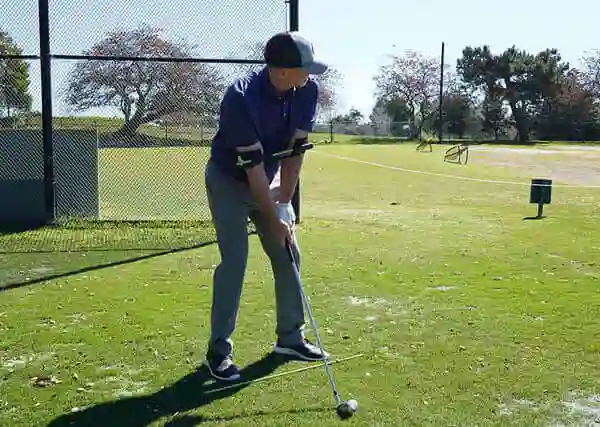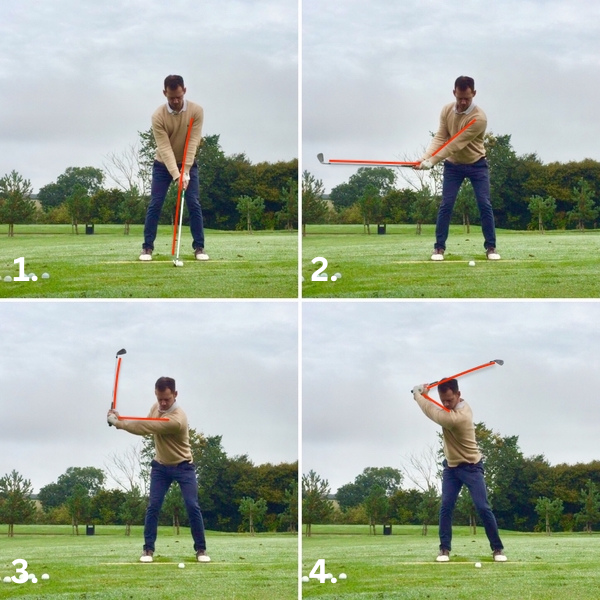In this step-by-step guide, we will break down the fundamentals of how to swing a golf club, from grip to follow-through. By following these techniques and practicing regularly, you can improve your swing and take your golf game to the next level. Let’s get started!
Master the Correct Golf Swing Technique
Step 1: Grip Positioning
The grip is the foundation of a proper golf swing, as it determines the club’s position and the player’s control over the club.
To achieve the correct grip, start by placing your dominant hand on the club first, with the club resting in the fingers rather than the palm.
Then, place your other hand below the dominant hand, ensuring the thumbs and forefingers of both hands form a “V” shape that points towards your dominant shoulder.
Check out the picture below to get a clearer understanding of the grip positioning technique.

Step 2: Stance and Posture
Your stance and posture are crucial in establishing a solid foundation for your golf swing. Start by standing with your feet shoulder-width apart, with your weight evenly distributed between them.
Bend your knees slightly, keeping them soft and flexible, and maintain a straight back, avoiding excessive slouching or arching.
Tilt your upper body slightly forward from the hips, allowing your arms to hang naturally from your shoulders. This alignment is key to a stable and effective swing.
Check out the picture below to get a clearer understanding of the Stance and Posture technique.

Step 3: The Backswing
The backswing is the first step in generating power and control in your golf swing. Begin by taking the club back with your dominant hand, keeping your arms relaxed and your wrists hinged.
As you continue, turn your shoulders and hips away from the target, maintain a steady head position and allow your weight to shift to your rear foot.
At the top of the backswing, your club should be parallel to the ground, and your weight should be evenly distributed between your feet.
Check out the pictures below to get a clearer understanding of the backswing technique.

Step 4: The Downswing
The downswing is the critical phase where you transfer the stored energy from your backswing into the ball. Start the downswing by shifting your weight to your front foot and allowing your hips to lead the way.
Keep your arms relaxed and your wrists hinged, allowing the club to naturally drop into the hitting zone.
As you approach impact, focus on keeping your head still and your eyes on the ball, ensuring a clean, powerful strike.
Check out the pictures below to get a clearer understanding of the downswing technique.

Step 5: Follow-Through
The follow-through is the final step in the golf swing, and it plays a crucial role in maintaining balance and control. After impact, allow your body to continue rotating, with your weight fully shifted to your front foot.
Keep your head still and your eyes on the ball.
Let your arms and club follow through naturally, with your front shoulder pointing towards the target.
Check out the picture below to get a clearer understanding of the follow-through technique.

Step 6: Consistency and Practice
Mastering the golf swing takes time, patience, and consistent practice. Incorporate these fundamental mechanics into your practice routine, paying attention to your grip, stance, backswing, downswing, and follow-through.
Regularly monitor your progress and make adjustments as needed, focusing on developing muscle memory and a consistent, repeatable swing.
Remember, the golf swing is a complex and dynamic movement, and each player’s technique may vary slightly. The key is to find the approach that works best for your body and swing mechanics, and to practice consistently to ingrain these fundamental principles into your game.
Common Mistakes to Avoid When Swinging a Golf Club
Swinging a golf club is a fundamental aspect of the game that greatly impacts your performance on the course. However, many golfers make common mistakes that can hinder their swing and overall gameplay. By avoiding these mistakes and following the correct steps, you can improve your swing technique and take your golf game to the next level.
Incorrect Grip
One of the most common mistakes golfers make when swinging a golf club is using an incorrect grip. The grip is the foundation of a good swing, and if it’s wrong, it can throw off the entire motion. To achieve the correct grip, place your lead hand at the top of the club, positioning your thumb pointing down the shaft. Then, interlock your trailing hand with your lead hand, ensuring both hands work together throughout the swing.
Poor Stance and Posture
Having a poor stance and posture can also significantly impact your swing. Ensure your feet are shoulder-width apart, knees slightly flexed, and your back straight but tilted slightly forward from the hips. This position provides balance and stability during the swing, allowing for a more fluid motion.
Improper Alignment
Alignment plays a crucial role in the direction of your shot. Many golfers neglect to align their body correctly with the target, leading to shots veering off course. Before taking your shot, ensure your feet, hips, and shoulders are parallel to the target line. This alignment sets you up for a more accurate and consistent swing.
Lack of Rotation
A successful golf swing requires proper rotation of the body. Failing to rotate your shoulders and hips during the swing can result in a lack of power and distance. Focus on rotating your shoulders fully on the backswing and following through with your hips on the downswing. This full-body rotation generates more power and allows for a more controlled shot.
Early Release
Another common mistake is early release, where the clubhead is released too early in the downswing. This action leads to a loss of power and can cause the club to make contact with the ball too early. To avoid early release, focus on maintaining wrist cock until the last possible moment before impact, maximizing the speed and accuracy of your swing.
By addressing and correcting these common mistakes in your golf swing, you can enhance your overall performance on the course. Remember to practice consistently and remain patient as improving your swing technique takes time and dedication. With the right approach and attention to detail, you can refine your swing and elevate your golf game.
FAQS
Q: What are the basic steps to swing a golf club?
A: Start with a proper grip: Hold the club with your fingers, not your palms, to allow for wrist hinge.
- Get in the right stance: Your feet should be shoulder-width apart, with the ball positioned to match the club you are using.
- Align your body: Your feet, hips, and shoulders should be parallel to the target line.
- Perform the backswing: Rotate your body while keeping your arms straight and shifting your weight to the back foot.
- Execute the downswing: Shift your weight to the front foot and rotate your body toward the target.
- Follow through: Continue the motion of the club after hitting the ball, with your body facing the target.
Q: How do I grip a golf club correctly?
A: There are several grip styles (e.g., interlocking, overlapping, ten-finger grip), but generally, you should hold the club in the fingers of your hands. The thumbs and index fingers of both hands should form a ‘V’ shape pointing towards your right shoulder (for right-handed players).
Q: Where should I position the ball in my stance?
A: The ball position varies with the club you are using. For longer clubs like drivers, position the ball near your front foot. For shorter clubs, like irons, the ball should be more centered in your stance.
Q: Why do I keep slicing or hooking the ball?
A: Slices and hooks can be caused by issues like improper grip, incorrect stance, or faulty swing mechanics. Analyzing your swing with a coach or using video can help identify and correct these issues.
Q: How can I improve my golf swing?
A: Practice consistently, focusing on the fundamentals like grip, stance, and swing mechanics. Consider taking lessons from a professional instructor to get personalized feedback and guidance.







